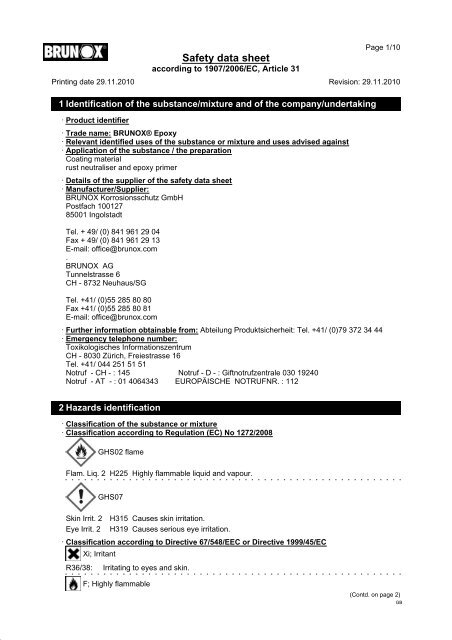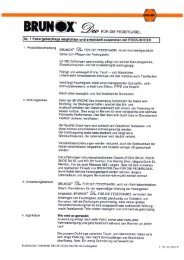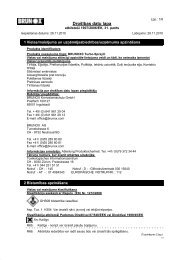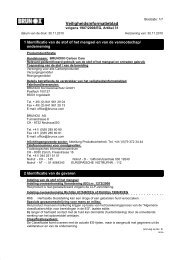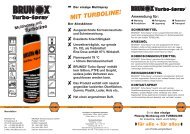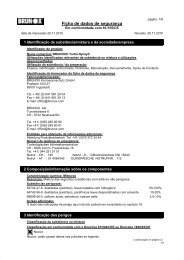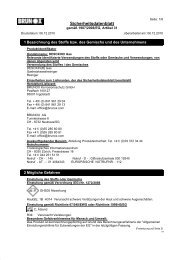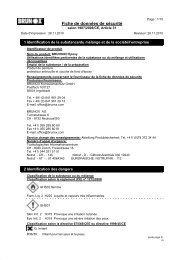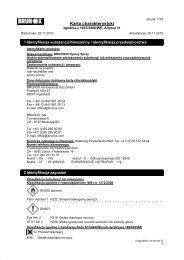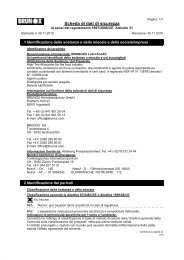Safety data sheet - Brunox
Safety data sheet - Brunox
Safety data sheet - Brunox
Create successful ePaper yourself
Turn your PDF publications into a flip-book with our unique Google optimized e-Paper software.
DR<br />
<strong>Safety</strong> <strong>data</strong> <strong>sheet</strong><br />
according to 1907/2006/EC, Article 31<br />
Page 1/10<br />
Printing date 29.11.2010 Revision: 29.11.2010<br />
1 Identification of the substance/mixture and of the company/undertaking<br />
· Product identifier<br />
· Trade name: BRUNOX® Epoxy<br />
· Relevant identified uses of the substance or mixture and uses advised against<br />
· Application of the substance / the preparation<br />
Coating material<br />
rust neutraliser and epoxy primer<br />
· Details of the supplier of the safety <strong>data</strong> <strong>sheet</strong><br />
· Manufacturer/Supplier:<br />
BRUNOX Korrosionsschutz GmbH<br />
Postfach 100127<br />
85001 Ingolstadt<br />
Tel. + 49/ (0) 841 961 29 04<br />
Fax + 49/ (0) 841 961 29 13<br />
E-mail: office@brunox.com<br />
.<br />
BRUNOX AG<br />
Tunnelstrasse 6<br />
CH - 8732 Neuhaus/SG<br />
Tel. +41/ (0)55 285 80 80<br />
Fax +41/ (0)55 285 80 81<br />
E-mail: office@brunox.com<br />
· Further information obtainable from: Abteilung Produktsicherheit: Tel. +41/ (0)79 372 34 44<br />
· Emergency telephone number:<br />
Toxikologisches Informationszentrum<br />
CH - 8030 Zürich, Freiestrasse 16<br />
Tel. +41/ 044 251 51 51<br />
Notruf - CH - : 145 Notruf - D - : Giftnotrufzentrale 030 19240<br />
Notruf - AT - : 01 4064343 EUROPÄISCHE NOTRUFNR. : 112<br />
2 Hazards identification<br />
· Classification of the substance or mixture<br />
· Classification according to Regulation (EC) No 1272/2008<br />
GHS02 flame<br />
Flam. Liq. 2 H225 Highly flammable liquid and vapour.<br />
GHS07<br />
Skin Irrit. 2 H315 Causes skin irritation.<br />
Eye Irrit. 2 H319 Causes serious eye irritation.<br />
· Classification according to Directive 67/548/EEC or Directive 1999/45/EC<br />
Xi; Irritant<br />
R36/38: Irritating to eyes and skin.<br />
F; Highly flammable<br />
(Contd. on page 2)<br />
GB
DR<br />
<strong>Safety</strong> <strong>data</strong> <strong>sheet</strong><br />
according to 1907/2006/EC, Article 31<br />
Page 2/10<br />
Printing date 29.11.2010 Revision: 29.11.2010<br />
(Contd. of page 1)<br />
R11: Highly flammable.<br />
· Information concerning particular hazards for human and environment:<br />
The product has to be labelled due to the calculation procedure of the "General Classification<br />
guideline for preparations of the EU" in the latest valid version.<br />
· Classification system:<br />
The classification is according to the latest editions of the EU-lists, and extended by company and<br />
literature <strong>data</strong>.<br />
· Label elements<br />
· Labelling according to EU guidelines:<br />
The product has been classified and marked in accordance with EU Directives / Ordinance on<br />
Hazardous Materials.<br />
· Code letter and hazard designation of product:<br />
Xi Irritant<br />
F Highly flammable<br />
· Risk phrases:<br />
11 Highly flammable.<br />
36/38 Irritating to eyes and skin.<br />
· <strong>Safety</strong> phrases:<br />
2 Keep out of the reach of children.<br />
7/9 Keep container tightly closed and in a well-ventilated place.<br />
23 Do not breathe fumes/aerosol.<br />
29/56 Do not empty into drains, dispose of this material and its container at hazardous or special<br />
waste collection point.<br />
46 If swallowed, seek medical advice immediately and show this container or label.<br />
51 Use only in well-ventilated areas.<br />
· Other hazards<br />
· Results of PBT and vPvB assessment<br />
· PBT: Not applicable.<br />
· vPvB: Not applicable.<br />
3 Composition/information on ingredients<br />
· Chemical characterization: Mixtures<br />
· Description: Mixture of substances listed below with nonhazardous additions.<br />
· Dangerous components:<br />
CAS: 108-10-1<br />
EINECS: 203-550-1<br />
CAS: 107-98-2<br />
EINECS: 203-539-1<br />
4-methylpentan-2-one<br />
Xn R20; Xi R36/37; F R11<br />
R66<br />
Flam. Liq. 2, H225; Acute Tox. 4, H332; Eye Irrit. 2, H319;<br />
STOT SE 3, H335<br />
1-methoxy-2-propanol<br />
R10<br />
Flam. Liq. 3, H226<br />
10-25%<br />
2.5-10%<br />
(Contd. on page 3)<br />
GB
DR<br />
<strong>Safety</strong> <strong>data</strong> <strong>sheet</strong><br />
according to 1907/2006/EC, Article 31<br />
Page 3/10<br />
Printing date 29.11.2010 Revision: 29.11.2010<br />
CAS: 67-63-0<br />
EINECS: 200-661-7<br />
propan-2-ol<br />
Xi R36; F R11<br />
R67<br />
Flam. Liq. 2, H225; Eye Irrit. 2, H319; STOT SE 3, H336<br />
CAS: 64-18-6 formic acid<br />
EINECS: 200-579-1 C R35<br />
Skin Corr. 1A, H314<br />
CAS: 112-34-5 2-(2-butoxyethoxy)ethanol<br />
EINECS: 203-961-6 Xi R36<br />
Eye Irrit. 2, H319<br />
· Additional information: For the wording of the listed risk phrases refer to section 16.<br />
4 First aid measures<br />
(Contd. of page 2)<br />
2.5-10%<br />
2.5-10%<br />
2.5-10%<br />
· Description of first aid measures<br />
· After inhalation:<br />
In case of unconsciousness place patient stably in side position for transportation.<br />
· After skin contact:<br />
If skin irritation continues, consult a doctor.<br />
Immediately wash with water and soap and rinse thoroughly.<br />
· After eye contact:<br />
Rinse opened eye for several minutes under running water. If symptoms persist, consult a doctor.<br />
· After swallowing: A person vomiting while laying on their back should be turned onto their side.<br />
· Information for doctor:<br />
· Most important symptoms and effects, both acute and delayed<br />
No further relevant information available.<br />
· Indication of any immediate medical attention and special treatment needed<br />
No further relevant information available.<br />
5 Firefighting measures<br />
· Extinguishing media<br />
· Suitable extinguishing agents: CO2, sand, extinguishing powder. Do not use water.<br />
· For safety reasons unsuitable extinguishing agents: Water with full jet<br />
· Special hazards arising from the substance or mixture<br />
Formation of toxic gases is possible during heating or in case of fire.<br />
· Advice for firefighters<br />
· Protective equipment:<br />
Wear self-contained respiratory protective device.<br />
Do not inhale explosion gases or combustion gases.<br />
· Additional information Cool endangered receptacles with water spray.<br />
6 Accidental release measures<br />
· Personal precautions, protective equipment and emergency procedures<br />
Ensure adequate ventilation<br />
Wear protective equipment. Keep unprotected persons away.<br />
· Environmental precautions:<br />
Do not allow product to reach sewage system or any water course.<br />
Inform respective authorities in case of seepage into water course or sewage system.<br />
Do not allow to enter sewers/ surface or ground water.<br />
(Contd. on page 4)<br />
GB
DR<br />
<strong>Safety</strong> <strong>data</strong> <strong>sheet</strong><br />
according to 1907/2006/EC, Article 31<br />
Page 4/10<br />
Printing date 29.11.2010 Revision: 29.11.2010<br />
(Contd. of page 3)<br />
· Methods and material for containment and cleaning up:<br />
Absorb with liquid-binding material (sand, diatomite, acid binders, universal binders, sawdust).<br />
Ensure adequate ventilation.<br />
Do not flush with water or aqueous cleansing agents<br />
· Reference to other sections<br />
See Section 7 for information on safe handling.<br />
See Section 8 for information on personal protection equipment.<br />
See Section 13 for disposal information.<br />
7 Handling and storage<br />
· Handling:<br />
· Precautions for safe handling<br />
Keep receptacles tightly sealed.<br />
Store in cool, dry place in tightly closed receptacles.<br />
Ensure good ventilation/exhaustion at the workplace.<br />
Prevent formation of aerosols.<br />
· Information about fire - and explosion protection:<br />
Keep ignition sources away - Do not smoke.<br />
Protect against electrostatic charges.<br />
· Conditions for safe storage, including any incompatibilities<br />
· Storage:<br />
· Requirements to be met by storerooms and receptacles:<br />
Store only in the original receptacle.<br />
Store in a cool location.<br />
· Information about storage in one common storage facility: Store away from foodstuffs.<br />
· Further information about storage conditions:<br />
Keep container tightly sealed.<br />
Store in cool, dry conditions in well sealed receptacles.<br />
· Specific end use(s) No further relevant information available.<br />
8 Exposure controls/personal protection<br />
· Additional information about design of technical facilities: No further <strong>data</strong>; see item 7.<br />
· Control parameters<br />
· Ingredients with limit values that require monitoring at the workplace:<br />
108-10-1 4-methylpentan-2-one<br />
WEL (Great Britain) Short-term value: 416 mg/m³, 100 ppm<br />
Long-term value: 208 mg/m³, 50 ppm<br />
Sk<br />
NES (Australia) Short-term value: 307 mg/m³, 75 ppm<br />
Long-term value: 205 mg/m³, 50 ppm<br />
WES (New Zealand) Short-term value: 307 mg/m³, 75 ppm<br />
Long-term value: 205 mg/m³, 50 ppm<br />
107-98-2 1-methoxy-2-propanol<br />
(Contd. on page 5)<br />
GB
DR<br />
<strong>Safety</strong> <strong>data</strong> <strong>sheet</strong><br />
according to 1907/2006/EC, Article 31<br />
Page 5/10<br />
Printing date 29.11.2010 Revision: 29.11.2010<br />
WEL (Great Britain)<br />
NES (Australia)<br />
WES (New Zealand)<br />
67-63-0 propan-2-ol<br />
WEL (Great Britain)<br />
NES (Australia)<br />
WES (New Zealand)<br />
64-18-6 formic acid<br />
WEL (Great Britain)<br />
NES (Australia)<br />
WES (New Zealand)<br />
Short-term value: 560 mg/m³, 150 ppm<br />
Long-term value: 375 mg/m³, 100 ppm<br />
Sk<br />
Short-term value: 553 mg/m³, 150 ppm<br />
Long-term value: 369 mg/m³, 100 ppm<br />
Short-term value: 553 mg/m³, 150 ppm<br />
Long-term value: 369 mg/m³, 100 ppm<br />
Short-term value: 1250 mg/m³, 500 ppm<br />
Long-term value: 999 mg/m³, 400 ppm<br />
Short-term value: 1230 mg/m³, 500 ppm<br />
Long-term value: 983 mg/m³, 400 ppm<br />
Short-term value: 1230 mg/m³, 500 ppm<br />
Long-term value: 983 mg/m³, 400 ppm<br />
Long-term value: 9.6 mg/m³, 5 ppm<br />
Short-term value: 19 mg/m³, 10 ppm<br />
Long-term value: 9.4 mg/m³, 5 ppm<br />
Short-term value: 19 mg/m³, 10 ppm<br />
Long-term value: 9.4 mg/m³, 5 ppm<br />
(Contd. of page 4)<br />
112-34-5 2-(2-butoxyethoxy)ethanol<br />
WEL (Great Britain) Short-term value: 101.2 mg/m³, 15 ppm<br />
Long-term value: 67.5 mg/m³, 10 ppm<br />
· Additional information: The lists valid during the making were used as basis.<br />
· Exposure controls<br />
· Personal protective equipment:<br />
· General protective and hygienic measures:<br />
Keep away from foodstuffs, beverages and feed.<br />
Immediately remove all soiled and contaminated clothing<br />
Wash hands before breaks and at the end of work.<br />
Do not inhale gases / fumes / aerosols.<br />
Avoid contact with the eyes and skin.<br />
· Respiratory protection:<br />
In case of brief exposure or low pollution use respiratory filter device. In case of intensive or longer<br />
exposure use self-contained respiratory protective device.<br />
· Protection of hands:<br />
Protective gloves<br />
The glove material has to be impermeable and resistant to the product/ the substance/ the<br />
preparation.<br />
Due to missing tests no recommendation to the glove material can be given for the product/ the<br />
preparation/ the chemical mixture.<br />
Selection of the glove material on consideration of the penetration times, rates of diffusion and the<br />
degradation<br />
· Material of gloves<br />
The selection of the suitable gloves does not only depend on the material, but also on further marks<br />
of quality and varies from manufacturer to manufacturer. As the product is a preparation of several<br />
substances, the resistance of the glove material can not be calculated in advance and has<br />
therefore to be checked prior to the application.<br />
(Contd. on page 6)<br />
GB
DR<br />
<strong>Safety</strong> <strong>data</strong> <strong>sheet</strong><br />
according to 1907/2006/EC, Article 31<br />
Page 6/10<br />
Printing date 29.11.2010 Revision: 29.11.2010<br />
(Contd. of page 5)<br />
· Penetration time of glove material<br />
The exact break through time has to be found out by the manufacturer of the protective gloves and<br />
has to be observed.<br />
· Eye protection:<br />
Tightly sealed goggles<br />
9 Physical and chemical properties<br />
· Information on basic physical and chemical properties<br />
· General Information<br />
· Appearance:<br />
Form: Fluid<br />
Colour: Amber coloured<br />
· Odour: Characteristic<br />
· Odour threshold: Not determined.<br />
· pH-value at 20°C: 4<br />
· Change in condition<br />
Melting point/Melting range: Undetermined.<br />
Boiling point/Boiling range: 82°C<br />
· Flash point: 13°C<br />
· Ignition temperature: 270°C<br />
· Decomposition temperature: Not determined.<br />
· Self-igniting: Product is not selfigniting.<br />
· Danger of explosion: Product is not explosive. However, formation of<br />
explosive air/vapour mixtures are possible.<br />
· Explosion limits:<br />
Lower: 1.7 Vol %<br />
Upper: 9.0 Vol %<br />
· Vapour pressure at 20°C: 8 hPa<br />
· Density at 20°C: 1 g/cm³<br />
· Relative density Not determined.<br />
· Vapour density Not determined.<br />
· Evaporation rate Not determined.<br />
· Solubility in / Miscibility with<br />
water: Not miscible or difficult to mix.<br />
· Segregation coefficient (n-octanol/water): Not determined.<br />
· Viscosity:<br />
Dynamic: Not determined.<br />
Kinematic:<br />
· Solvent content:<br />
Not determined.<br />
Organic solvents: 39.6 %<br />
VOC (EC) 39.65 %<br />
(Contd. on page 7)<br />
GB
DR<br />
<strong>Safety</strong> <strong>data</strong> <strong>sheet</strong><br />
according to 1907/2006/EC, Article 31<br />
Page 7/10<br />
Printing date 29.11.2010 Revision: 29.11.2010<br />
Solids content: 47.3 %<br />
· Other information No further relevant information available.<br />
10 Stability and reactivity<br />
· Reactivity<br />
· Chemical stability<br />
· Thermal decomposition / conditions to be avoided:<br />
No decomposition if used according to specifications.<br />
· Possibility of hazardous reactions No dangerous reactions known.<br />
· Conditions to avoid No further relevant information available.<br />
· Incompatible materials: No further relevant information available.<br />
· Hazardous decomposition products: No dangerous decomposition products known.<br />
11 Toxicological information<br />
(Contd. of page 6)<br />
· Information on toxicological effects<br />
· Acute toxicity:<br />
· LD/LC50 values relevant for classification:<br />
108-10-1 4-methylpentan-2-one<br />
Oral LD50 2080 mg/kg (rat)<br />
Dermal LD50 16000 mg/kg (rab)<br />
Inhalative LC50/4 h 8.3-16.6 mg/l (rat)<br />
· Primary irritant effect:<br />
· on the skin:<br />
Bei längeren und/oder häufigem Hautkontakt sind Reizerscheinungen möglich.<br />
Prolonged skin contact will result in defatting of the skin, leading to irritation, and in some cases,<br />
dermatitis.<br />
Irritant to skin and mucous membranes.<br />
· on the eye: Irritating effect.<br />
· Sensitization: No sensitizing effects known.<br />
· Additional toxicological information:<br />
The product shows the following dangers according to the calculation method of the General EU<br />
Classification Guidelines for Preparations as issued in the latest version:<br />
Irritant<br />
12 Ecological information<br />
· Toxicity<br />
· Acquatic toxicity: No further relevant information available.<br />
· Persistence and degradability No further relevant information available.<br />
· Behaviour in environmental systems:<br />
· Bioaccumulative potential No further relevant information available.<br />
· Mobility in soil No further relevant information available.<br />
· Additional ecological information:<br />
· General notes:<br />
Water hazard class 2 (German Regulation) (Self-assessment): hazardous for water<br />
Do not allow product to reach ground water, water course or sewage system.<br />
Danger to drinking water if even small quantities leak into the ground.<br />
(Contd. on page 8)<br />
GB
DR<br />
<strong>Safety</strong> <strong>data</strong> <strong>sheet</strong><br />
according to 1907/2006/EC, Article 31<br />
Page 8/10<br />
Printing date 29.11.2010 Revision: 29.11.2010<br />
· Results of PBT and vPvB assessment<br />
· PBT: Not applicable.<br />
· vPvB: Not applicable.<br />
· Other adverse effects No further relevant information available.<br />
13 Disposal considerations<br />
(Contd. of page 7)<br />
· Waste treatment methods<br />
· Recommendation<br />
Must not be disposed together with household garbage. Do not allow product to reach sewage<br />
system.<br />
· European waste catalogue<br />
20 01 28 paint, inks, adhesives and resins other than those mentioned in 20 01 27<br />
20 01 39 plastics<br />
· Uncleaned packaging:<br />
· Recommendation: Disposal must be made according to official regulations.<br />
14 Transport information<br />
· Land transport ADR/RID (cross-border)<br />
· ADR/RID class: 3 Flammable liquids.<br />
· Danger code (Kemler): 33<br />
· UN-Number: 1866<br />
· Packaging group: II<br />
· Hazard label: 3<br />
· UN proper shipping name: 1866 RESIN SOLUTION, special provision 640D<br />
· Tunnel restriction code D/E<br />
· Maritime transport IMDG:<br />
· IMDG Class: 3<br />
· UN Number: 1866<br />
· Label 3<br />
· Packaging group: II<br />
· EMS Number: F-E,S-E<br />
· Marine pollutant: No<br />
· Proper shipping name: RESIN SOLUTION<br />
(Contd. on page 9)<br />
GB
DR<br />
<strong>Safety</strong> <strong>data</strong> <strong>sheet</strong><br />
according to 1907/2006/EC, Article 31<br />
Page 9/10<br />
Printing date 29.11.2010 Revision: 29.11.2010<br />
· Air transport ICAO-TI and IATA-DGR:<br />
· ICAO/IATA Class: 3<br />
· UN/ID Number: 1866<br />
· Label 3<br />
· Packaging group: II<br />
· Proper shipping name: RESIN SOLUTION<br />
(Contd. of page 8)<br />
· UN "Model Regulation": UN1866, RESIN SOLUTION, 3, II<br />
· Special precautions for user Warning: Flammable liquids.<br />
· Transport in bulk according to Annex II of MARPOL73/78 and the IBC Code Not applicable.<br />
15 Regulatory information<br />
· <strong>Safety</strong>, health and environmental regulations/legislation specific for the substance or<br />
mixture<br />
· Labelling according to EU guidelines:<br />
The product has been classified and marked in accordance with EU Directives / Ordinance on<br />
Hazardous Materials.<br />
· Code letter and hazard designation of product:<br />
Xi Irritant<br />
F Highly flammable<br />
· Risk phrases:<br />
11 Highly flammable.<br />
36/38 Irritating to eyes and skin.<br />
· <strong>Safety</strong> phrases:<br />
2 Keep out of the reach of children.<br />
7/9 Keep container tightly closed and in a well-ventilated place.<br />
23 Do not breathe fumes/aerosol.<br />
29/56 Do not empty into drains, dispose of this material and its container at hazardous or special<br />
waste collection point.<br />
46 If swallowed, seek medical advice immediately and show this container or label.<br />
51 Use only in well-ventilated areas.<br />
· Chemical safety assessment: A Chemical <strong>Safety</strong> Assessment has not been carried out.<br />
16 Other information<br />
This information is based on our present knowledge. However, this shall not constitute a guarantee<br />
for any specific product features and shall not establish a legally valid contractual relationship.<br />
· Relevant phrases<br />
H225 Highly flammable liquid and vapour.<br />
H226 Flammable liquid and vapour.<br />
H314 Causes severe skin burns and eye damage.<br />
H319 Causes serious eye irritation.<br />
H332 Harmful if inhaled.<br />
(Contd. on page 10)<br />
GB
DR<br />
<strong>Safety</strong> <strong>data</strong> <strong>sheet</strong><br />
according to 1907/2006/EC, Article 31<br />
Page 10/10<br />
Printing date 29.11.2010 Revision: 29.11.2010<br />
H335 May cause respiratory irritation.<br />
H336 May cause drowsiness or dizziness.<br />
(Contd. of page 9)<br />
R10 Flammable.<br />
R11 Highly flammable.<br />
R20 Harmful by inhalation.<br />
R35 Causes severe burns.<br />
R36 Irritating to eyes.<br />
R36/37 Irritating to eyes and respiratory system.<br />
R66 Repeated exposure may cause skin dryness or cracking.<br />
R67 Vapours may cause drowsiness and dizziness.<br />
· Department issuing MSDS: Abteilung Produktsicherheit<br />
· Contact: siehe Seite 1 / see page 1<br />
· Abbreviations and acronyms:<br />
ADR: Accord européen sur le transport des marchandises dangereuses par Route (European Agreement concerning the<br />
International Carriage of Dangerous Goods by Road)<br />
RID: Règlement international concernant le transport des marchandises dangereuses par chemin de fer (Regulations<br />
Concerning the International Transport of Dangerous Goods by Rail)<br />
IMDG: International Maritime Code for Dangerous Goods<br />
IATA: International Air Transport Association<br />
IATA-DGR: Dangerous Goods Regulations by the "International Air Transport Association" (IATA)<br />
ICAO: International Civil Aviation Organization<br />
ICAO-TI: Technical Instructions by the "International Civil Aviation Organization" (ICAO)<br />
GHS: Globally Harmonized System of Classification and Labelling of Chemicals<br />
VOC: Volatile Organic Compounds (USA, EU)<br />
LC50: Lethal concentration, 50 percent<br />
LD50: Lethal dose, 50 percent<br />
GB


